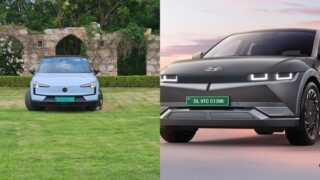Share via: The EX30 is priced at ₹39.99 lakh ex-showroom for early bookings made before October 19, 2025, rising to ₹41 lakh thereafter. By comparison, the Hyundai Ioniq 5 sits around ₹46 lakh. …Read More The EX30 is priced at ₹39.99 lakh ex-showroom for early bookings made before October 19, 2025, rising to ₹41 lakh thereafter. By comparison, the Hyundai Ioniq 5 sits around ₹46 lakh View Personalised Offers on Check Offers The Indian premium EV segment is quietly gaining steam, and two names dominate the discussion: the newly launched Volvo/ex30″>Volvo EX30 and the tried-and-true Hyundai/ioniq5″>Hyundai Ioniq 5. One is Volvo’s smallest, most aggressively priced EV to date, designed to win over aspirational consumers, while the Ioniq 5 has already proved itself to be a mainstream premium EV with an enviable reputation for practicality, technology, and reliability. Both are competing for attention in a market where buyers increasingly care about design, performance, features, and brand credibility. Volvo EX30 vs Hyundai Ioniq 5: PriceVolvo is entering India with a bold play. The EX30 is priced at ₹39.99 lakh ex-showroom for early bookings made before October 19, 2025, rising to ₹41 lakh thereafter. By comparison, the Hyundai Ioniq 5 sits around ₹46 lakh, ex-showroom. That makes Volvo’s option significantly cheaper, particularly for customers who desire the prestige of a luxury brand without spending deep into ₹50 lakh levels. The price difference isn’t merely figures on paper, it translates to actual flexibility for customers who wish to enjoy Scandinavian styling, state-of-the-art technology, and an EV badge without going overboard. In many ways, Volvo is challenging the conventional logic: you don’t need to spend a fortune to get into the luxury EV segment, and that makes the EX30 a very interesting proposition. Also Read : Volvo EX30 electric SUV launched in India, priced at ₹39.99 lakh Volvo EX30 vs Hyundai Ioniq 5: SpecsThe Volvo EX30 is small but does not lack punch. Its 69 kWh battery has an estimated range of some 480 km, sufficient to cover most urban and weekend journeys with ease. Power figures are impressive for a compact EV, with around 272 hp and 343 Nm of torque. That translates into a brisk 0–100 km/h acceleration in just 5.3 seconds, giving it a sporty edge that many other premium EVs in this bracket can’t match. Volvo also promises a top speed of 180 km/h and fast charging that takes the battery from 10 per cent to 80 per cent in about 28 minutes, ensuring minimal downtime. The company adds a generous warranty, 8 years or 1,60,000 km on the battery and three years on the vehicle itself, including a service package and digital perks like “Connect Plus.” On the other hand, the Hyundai Ioniq 5 leans more toward a practical, spacious EV experience. Its 72.6 kWh battery, paired with a rear-wheel-drive motor, gives a real-world range of around 480 km in India. While acceleration is a touch slower at around 7.6 seconds for 0–100 km/h, the Ioniq 5’s 800V electrical architecture allows extremely fast charging and more efficient power management. With a top speed of 185 km/h and proven software and hardware reliability, the Ioniq 5 appeals to buyers who want confidence in day-to-day usability. Essentially, EX30 is about sporty engagement, while Ioniq 5 is about mature, dependable performance. Volvo EX30 vs Hyundai Ioniq 5: FeaturesStep into the Volvo EX30, and you immediately get a sense that the designers were trying to do more with less. The cabin is compact, but it doesn’t feel cramped; instead, there’s a quiet clarity to the space. Materials are well selected: recycled plastics, fibers, even denim scraps end up in the surfaces, which imbues it with a quietly green sensibility without boasting. The 12.3-inch vertical screen is positioned front and center, intuitive enough to handle navigation, apps, and voice commands without converting the cabin into a gadget store. Safely in keeping with Volvo’s tradition, safety is integrated into the experience, not added on: several cameras, sensors, and driver-assistance capabilities quietly scan your surroundings. The EX30 also has a panoramic glass roof and an NFC card key, practical touches that elevate the day-to-day experience. That said, being a compact SUV, it can’t compete with larger rivals in rear-seat space or boot capacity, but it manages its limits thoughtfully, particularly for urban driving. The Hyundai Ioniq 5, by contrast, feels like a breath of open space. Its cabin immediately communicates roominess and versatility. It gets dual 12.3-inch screens that integrate instrumentation and infotainment, and a sliding center console that is dubbed as the “Universal Island”. Cargo space is generous for a car of its size, and the vehicle supports a robust charging ecosystem that can even accommodate Tesla’s NACS adapters in some markets. Safety is thorough, with multiple airbags, ABS, stability control, and driver-assistance tech that quietly does its job. Check out Upcoming EV Cars in India. First Published Date: 26 Sept 2025, 11:38 am IST
Source: hindustantimes.com






